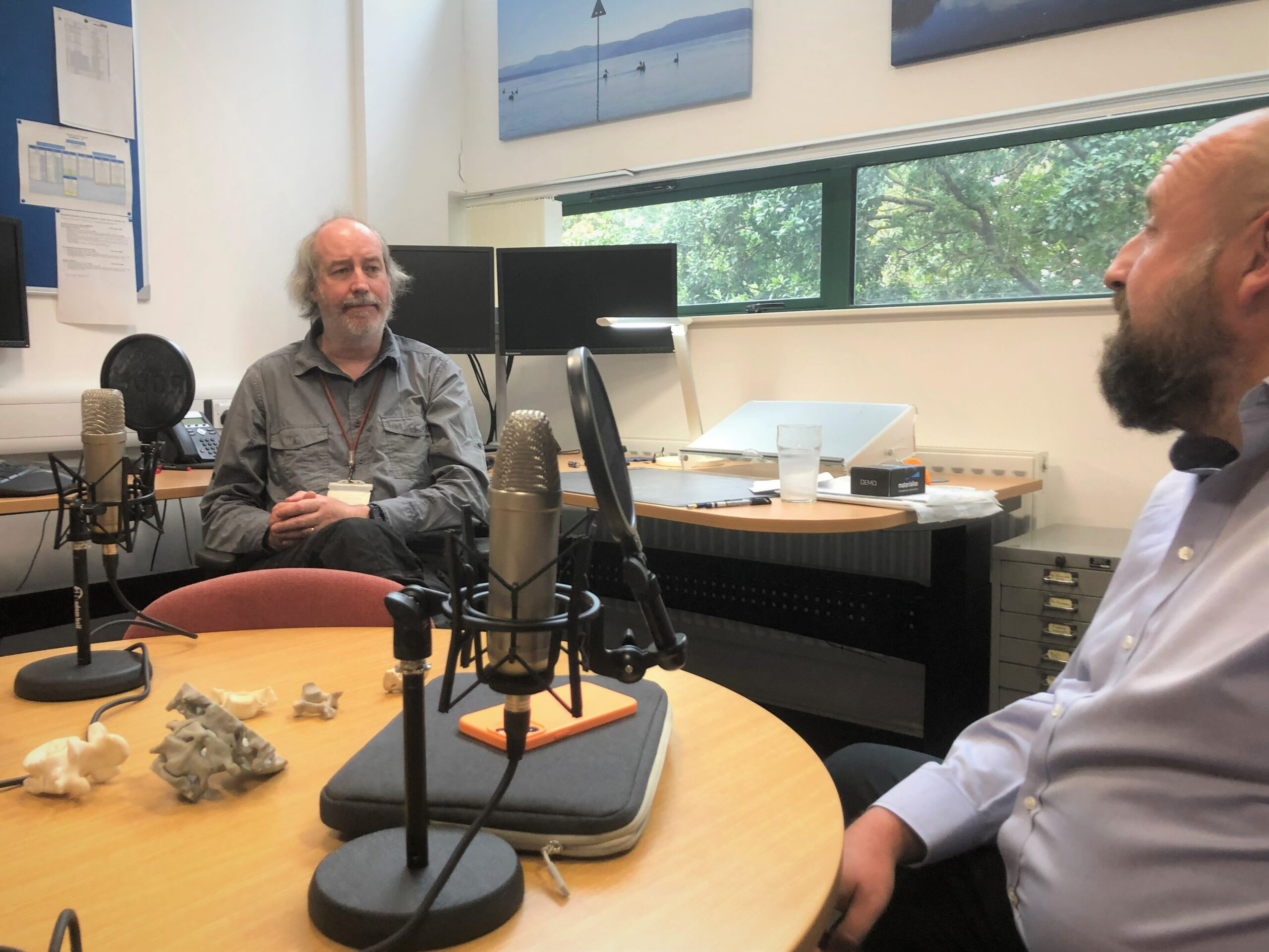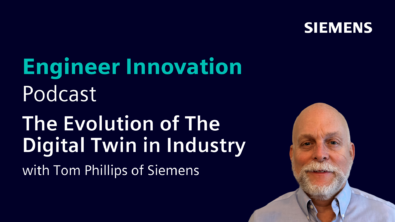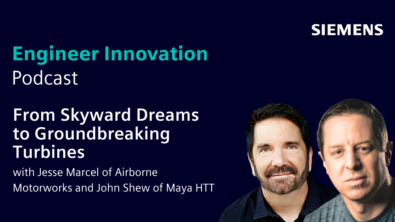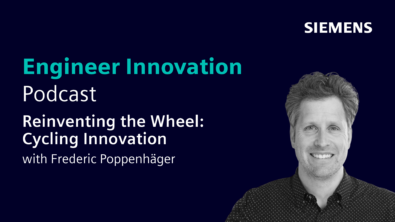Solved with Simcenter: the mystery of a hit-and-run cycling accident (Episode 10)

Solving the mystery of a hit-and-run accident
Every cyclist’s worst nightmare is to end up unconscious in a roadside ditch due to a collision with a motor vehicle.
In 2010 Nottingham University’s Professor Donal McNally woke up from such an accident, in a roadside ditch, with no recollection of what happened to him:
“What I’m aware of is that I cycled home one evening, and I can remember a road junction about a mile before the collision. And that’s the last thing I can remember. The next thing I can remember is being loaded into the ambulance.”
McNally’s injuries were severe, including head trauma, a broken neck and spinal fractures that would see him hospitalized for two weeks and would cause him to miss four months of work. Ironically Professor McNally had been researching spinal biomechanics for more than two decades before the accident. Much of that research involved simulating how the human skeleton reacts to the stress of a road traffic accident.
In this episode of the Engineer Innovation podcast, we learn how Professor McNally used Simcenter to recreate his accident and solve the mystery of his unusual injury pattern. He also explains how the simulation model he developed resolved a long-standing controversy in the cycling community about the role of lightweight helmets in protecting riders from high-energy collisions.
You can read more about Professor McNally’s accident, and the simulations that solved the mystery, in the Engineer Innovation Healthier World Edition.
Exploding heart valves
Professor McNally also talks about how simulation is used to understand aortic rupture – literally an exploding heart valve – in high-energy impact situations, such as motor vehicle collisions or people jumping from buildings. Aortic valve ruptures are almost always fatal and, after head trauma, are the second most frequent cause of death in car crashes.
Designing floors that are safe for falling
Finally, Professor McNally explains how simulation is helping to explain the role that flooring design could play in protecting older people from falls.
- What Donal remembers from the accident (01:42)
- How Donal solved the mystery of what happened to him (02:48)
- Computer simulations are able to safely test the efficacy of helmets (04:30)
- What the SimCenter Madymo is used for (06:56)
- How safe flooring can help with fall prevention (13:17)
[00:13] Stephen Ferguson: Every cyclist’s worst nightmare is to end up unconscious in a roadside ditch as a victim of a road traffic accident. If a cyclist is lucky, then a motorist will stop their vehicle and immediately call for emergency medical assistance. However, if they’re unlucky, then perhaps the motorist will flee the scene. And if they’re truly unlucky, then it may never ever wake up at all. One victim of such an accident is Nottingham University’s Professor Donal McNally, who was the victim of a hit-and-run accident in 2010 while cycling to work. Although Professor McNally has no recollection of the instance that led to the collision, he did manage to use Simcenter to reconstruct the accident and solve the mystery of what happened to him. When I met with Donal, I started off by asking him to describe exactly what he did remember from the accident.
[01:05] Donal McNally: What I’m aware of is I cycled home one evening, and I can remember a road junction about a mile before the collision actually happened, and that’s the last thing I can remember. I can remember waking up to the ambulance crew who were loading me onto the ambulance. I had three fractures in my neck: one in my lower back and a couple of fractured ribs, and arms and legs were absolutely fine. They were a bit crazed that there was no serious damage. So it really puzzled me when I was lying on the spine board, unable to move or do anything, why being hit by a car would do that.
[01:49] Stephen Ferguson: So you’ve woken up, you have no recollection of the accident, you need to try and solve this mystery of what happened to you. I think it was a hit-and-run accident, so there was no evidence from the car at the time. But I think, eventually, they found the driver and found the car. So you could tell a bit more from the damage to the car what had happened. How did you go about solving the mystery of what happened to you?
[02:11] Donal McNally: It became apparent from the damage to the car that I’d been hit fairly much squarely from behind. I’d take the wing off the front of the car and left a dent in the windscreen. I knew I’ve been hit fairly square on by just that inside edge of the car, which is the stiffest, it’s the hardest bit of the car to hit. If I’d hit the middle of the windscreen, it might have been a bit different. But it was still a bit of a puzzle why I had what were compression fractures in my neck. My helmet was badly damaged. And it seemed to be an impact somewhere between my forehead and the top of my head. And I clearly had a head injury, which is why I couldn’t remember things. So it was a bit of a mystery. Because I was able to actually do a simulation of sorts of things that might have happened to me, I was able to piece together the event. And what seems to have happened to me is that I was hit by the car, and that knocked the bicycle out from underneath me without actually seriously impacting me. So I think the bike did the damage to the wing of the car. I bounced off the windscreen pillar, which is what I think caused my lower back fracture. And then essentially, I backflips over the top of the car and landed on my head, and that’s why I have compression fractures in my neck.
[03:41] Stephen Ferguson: So as an academic, there must have been a certain sense of relief in satisfying your curiosity about what happened to you and solving the mystery of the accident. Was that the feeling?
[03:53] Donal McNally: It was very gratifying to actually work out the full cycle of events. There’s an academic appeal to that. But more importantly, it meant I could do some research. One of the things that’s really hard to do with things like seeing how effective bicycle helmets are is every accident is different, and you can’t ethically give a group of people bicycle helmets and take bicycle helmets away from the other group and then hit them with cars in a controlled fashion. But what you can do with a computer simulation is you can just switch a helmet on and off and you can make a direct comparison for exactly the same set of circumstances; “This is what would have happened with a helmet, and this is what would have happened without them.” So, we were able to look, not just at the accident that happened to me, but also look at some other common cycle events on bicycles that lead to head injuries. We can see where cycle helmets were effective, and they were very effective in low-energy impacts where the head hits the ground. Obviously, that’s not going to work; the head doesn’t hit the ground. And it’s quite possible to get a head injury because your head is accelerated by your body being impacted. So if you land on your shoulder, that can cause a head injury without your head ever touching anything. But it also showed that even in the very high energy accidents, a lot of the time, the helmets were effective because you think of cars doing 40-50 miles an hour, and that hitting an expanded polystyrene helmet, what could the helmet possibly do with that? Whereas that’s not actually what’s giving you the head injury, that’s not what’s causing the problem. All the car does is throw you up in the air, and it’s the landing on the ground, basically, in every case, it was the head hitting the ground that actually caused the injury. So, you are just talking about falling a meter or meter and a half, that’s the mechanism of injury, not the speed of the car so much.
[05:54] Stephen Ferguson: So we’ve just talked about a rather unusual and very interesting example of how you used Simcenter Madymo to solve the mystery of what happened to you and how you can demonstrate the efficacy of cycling helmets in preventing injury for cyclists. Next, I want to move on to your day-to-day use of Simcenter Madymo, what do you use it for normally? I guess it’s not predicting the outcome of cycling accidents.
[06:18] Donal McNally: Car crash simulation sort of tend to use Simcenter Madymo a little bit at the edge of what it’s used for. Another project I’ve used it for has been looking at the rupture of the aorta. This sort of weird, high acceleration injury that happens in car crashes, motorcycle crashes, people jumping out of windows, they are able to basically explode. And I think 80% of the time, it happens at one particular place in the aorta. So I’ve done modeling of aortas, but you need to put an input into that to simulate the impact. So, we talked to the Accident Investigation Unit, and they were able to give us what they knew about the crashes that have had this rupture, so we were actually able to use the measurements of how much the car had crushed, and to then work out what has happened to the car and then we were able to use Simcenter Madymo to look at what has happened to the occupant and then we could use what had happened to the occupant to look at what had happened to the aorta. Again, there was a real variety of different impacts. We had some frontal ones. There was a side impact we were really quite struggling to work out how it created that sort of thing until we ran the Simcenter Madymo simulation and the driver bounced off the door pillar that gave a really high acceleration impact onto the shoulder.
[07:55] Stephen Ferguson: The consequences of a bursting aorta are fatal.
[07:59] Donal McNally: Yeah, they’re usually daunting. I think they’ve got better at dealing with them if they get into any. But you’ve got a big hole in a big blood vessel, and it’s in a place where the blood coming out then causes further problems. If you’re just filling up with blood, then you’re breathing doesn’t work very well, and not a good thing. Princess Diana died of something similar; it was her pulmonary artery, I think, that ruptured.
[08:27] Stephen Ferguson: There’s nothing been pierced, it’s just the pressure.
[08:32] Donal McNally: Something happening. It seems to be just a high acceleration of the chest that causes this. I think it probably has more to do with the anatomy of the aorta, and there are all sorts of weird stuff going on. So, when you’re a fetus inside your mother, you don’t need blood to go around your lungs because you haven’t got any air in your lungs. So there are a couple of short circuits in the system so that the right-hand side of your heart pumps blood around the body as well as the left-hand side. So there’s a hole between the two pumping chambers of the heart, the pulmonary trunk to the aorta. So when you’re born, at the moment of birth, the holes close up, but it leaves a scar on the aorta where the tube turns into almost a ligament so the wall of the aorta is just a bit different and at the point where it ruptures. So that could be the weakness. The aorta is sort of stuck to the front of your spine most of the way down, and it’s just above the mobile bits. And there are more theories than you can imagine as to why it does it, at that particular point. It just seems to be high acceleration. I don’t believe there’s ever been a Formula One driver who had an aortic rupture because the restraints, the cars, and the tracks are designed so you don’t get those high explorations. Your chest is never hitting anything hard and the car is never hitting anything hard, that’s why they have the tire walls and things like that. So there are all sorts of interesting clues, which was why we’re looking at it. But, certainly, at that stage, it was the second most common cause of sudden death in a car crash after head injuries. The rate of people being killed and seriously injured in cars has dropped by 80%. The sort of crash testing and then the Simcenter Madymo type simulations, perhaps some of the most facilitated modelings of car mechanics now have worked so well with cars, and it’s going the other way with bicycles. It’s getting worse. You’re more likely to be killed or seriously injured now than you used to. It’s something like a third of all people who suffer hip fractures are dead within a year. And part of that is because they’re old, so they’re more likely to die. But a lot of it is to do with the fact that they’re less mobile so they’re less fit. If they’re having prolonged time in bed, then it increases the risk of chest infections and all the horrid things that kill off old people.
[11:12] Stephen Ferguson: Or make their lives miserable. The campaign that we’re working on is based around the fact that — I think they’re saying at the moment — a five-year-old child or somebody who is born in the last five years in the US has about a 50% chance of living to be 100. And of course, living to be 100 doesn’t mean just being alive to be 100, you have to be mobile and increasingly productive as well because you can’t expect to retire at 60 and live retired for 40 years. So those kinds of injuries are the things that either kill people or make their lives absolutely miserable. You don’t want to live to 100 in absolute abject pain and immobility.
[11:44] Donal McNally: And incredibly expensive. If you think about the amount of care that someone requires for a very low quality of life, there’s a lot of work and money going into fall prevention. But I sort of feel in my mom’s case, she’d broken her hip, they knew she was at much greater risk of falling so they actually had someone who was sitting within arm’s length of her all the time, just one on one, to make sure she shouldn’t fall and she still fell. So, whatever you do, people are still going to fall. And then you need to start thinking about how you mitigate those injuries and reduce the severity of the outcome.
[12:32] Female Speaker: The research that you’re doing now on the falls, what do you want to do with that result? What would that change?
[12:40] Donal McNally: I want hospitals and care homes to think about the full safety of flooring when they put it in. And it’s remarkable, an awful lot of care goes into things like flooring selection. So the place my mother was at was a dementia unit, and there have been studies that people with dementia perceive changes in floor flooring as being a potential barrier. I don’t know if it gives them the same warnings that there might be a step or something. So, having uniform flooring that just goes from the corridor into rooms is important. Even things like not having a flight commonly in the pattern because then they see something and they bend over and try and pick it up and fall over. So they’re thinking at that level, but they’re still putting something that will cause a serious injury if someone falls on it. So my long-term goal is to have the flooring comes with a rating for wearability and ease of cleaning, that there is a soft form for high-risk areas like toilet areas.
[13:59] Stephen Ferguson: Like [13:59 inaudible] rating for floors, it’s a great idea and also something which is very, very commercializable. People will jump on that.
[14:07] Donal McNally: Apparently there’s resistance to having compliant flooring because it’s perceived to make pushing beds and things like that on it. You just make tiles on the beds bigger or there are ways around that. There’s also concern that if you’ve got a softer floor, it’s more unstable so people are more likely to fall so they’ll work themselves less but they’ll fall over more. I think that came from some early work which had very compliant, so it was getting people to work on crash mats almost. Whereas something that’s compliant is the carry mats that you take camping. Something like that will turn someone falling out of bed and hitting the back of their head on the ground from a fatal injury to something that’s a minor concussion. So, it’ll still be a nasty bang on the head. Again, if they fell out and landed on the greater trochanter that’s outside of the hip, that will break their hip. But if they fall on something like the carry mat, not so much. So, this summer, I’ve had a student at a human performance lab up in the small center. And we’ve been getting old people in and getting them to stand on different sorts of flooring and looking at how that affects their balance. We’ve got force plates, which measure the location of your center of gravity, basically. And standing up on some sort of unstable thing, which is why you fall over when you’re drunk. And the people who balanced really well can keep their center of gravity almost stationary, they make very, very small adjustments, whereas people with poor balance just wobble all over the place. So, that’s what we’ve been doing.
[15:54] Stephen Ferguson: Some things we talked about today are things that have the potential, I think, to affect everybody. Most of us have fallen off a bicycle at least once in our lives, although hopefully not because we’ve been hit by a car. Almost everybody would have been involved in a road traffic accident, although hopefully, one that’s not serious enough to rupture our heart aorta. And hopefully, most of us will live long enough to see the flooring designs that Professor McNally is working with companies to introduce so that when we’re elderly, when we inevitably fall over, we don’t cause ourselves permanent, painful harm. So, it just remains for me to say thank you to Professor McNally, who’s been an excellent guest. Thank you to Nottingham University for being our hosts. And thank you to you for listening to another edition of the Engineer Innovation podcast.

Stephen Ferguson – Host
Stephen Ferguson is a fluid-dynamicist with more than 30 years of experience in applying advanced simulation to the most challenging problems that engineering has to offer for companies such as WS Atkins, BMW and CD-adapco and Siemens. Stephen is a particularly clumsy runner and cyclist and has a permanently broken collarbone and metal shoulder due to collisions with hard objects.

Professor Donal McNally – Guest
Professor McNally has researched spinal biomechanics at Nottingham University for over three decades. Thirteen years after the accident that almost ended his life, McNally is still a keen cyclist and an advocate for the use the cycling helmets. Professor McNally doesn’t mind making a fool of himself by “dressing up like a highlighter pen” to keep safe on his bike.
Stuff to watch:
Good reads:
- in vivo, in vitro, in silico: unleashing innovation in medical device development
- Simcenter for a Healthier World
- 5 ways in which engineering simulation will help us live longer, happier and more productive lives

Engineer Innovation Podcast
A podcast series for engineers by engineers, Engineer Innovation focuses on how simulation and testing can help you drive innovation into your products and deliver the products of tomorrow, today.



